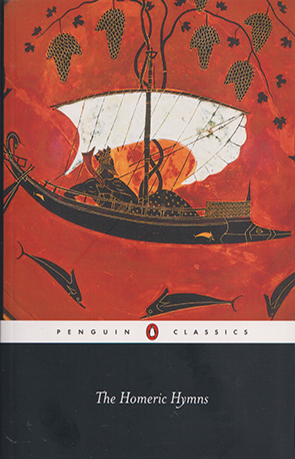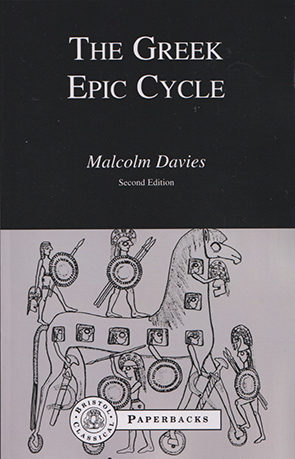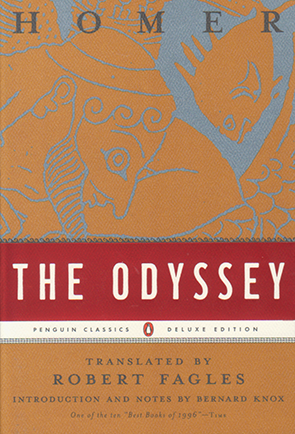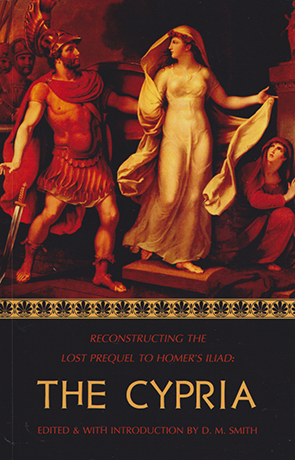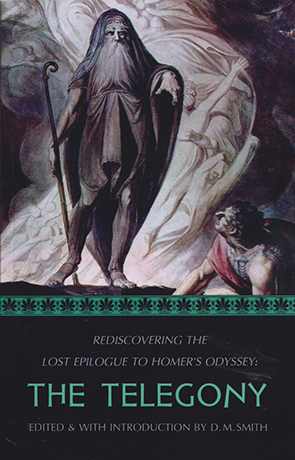
The Epic Cycle
- Theogony and Titanomachy
- Oedipodea
- Thebaid
- Epigoni
- Alcmeonis
- The Cypria
- Book 1: The Rage of Achilles
- Book 2: The Great Gathering of Armies
- Book 3: Helen Reviews the Champions
- Book 4: The Truce Erupts in War
- Book 5: Diomedes Fights the Gods
- Book 6: Hector Returns to Troy
- Book 7: Ajax Duels with Hector
- Book 8: The Tide of Battle Turns
- Book 9: The Embassy to Achilles
- Book 10: Marauding Through the Night
- Book 11: Agamemnon’s Day of Glory
- Book 12: The Trojans Storm the Rampart
- Book 13: Battling for the Ships
- Book 14: Hera Outflanks Zeus
- Book 15: The Achaean Armies at Bay
- Book 16: Patroclus Fights and Dies
- Book 17: Menelaus’ Finest Hour
- Book 18: The Shield of Achilles
- Book 19: The Champion Arms for Battle
- Book 20: Olympian Gods in Arms
- Book 21: Achilles Fights the River
- Book 22:The Death of Hector
- Book 23:Funeral Games for Patroclus
- Book 24:Achilles and Priam
- Aethiopis
- Ilias Parva ("Little Iliad")
- Iliou persis ("Sack of Troy")
- Nostoi ("returns")
- Book 1:Athena Inspires the Prince
- Book 2:Telemachus Sets Sail
- Book 3:King Nestor Remembers
- Book 4: The King and Queen of Sparta
- Book 5: Odysseus - Nymph and Shipwreck
- Book 6: The Princes and the Stranger
- Book 7: Phaeacia's Halls and Gardens>
- Book 8: A Day for Songs and Contests
- Book 9: In the One-Eyed Giant's Cave
- Book 10: The Bewitching Queen of Aeaea
- Book 11: The Kingdom of the Dead
- Book 12: The Cattle of the Sun
- Book 13: Ithaca at Last
- Book 14: The Loyal Shepherd
- Book 15: The Prince Sets Sail for Home
- Book 16: Father and Son
- Book 17: Stranger at the Gates
- Book 18: The Beggar-King of Ithaca
- Book 19: Penelope and Her Guests
- Book 20: Portents Gather
- Book 21: Odysseus Strings His Bow
- Book 22: Slaughter in the Hall
- Book 23: The Great Rooted Bed
- Book 24: Peace
- The Telegony
Introduction
This reading project is a work in progress and will remain unfinished for some time. At the moment I have only completed pages for The Iliad. The Odyssey is currently being read and I am writing pages for that as I go. Use the menu to access pages in this project. Items in grey have no page yet. Options for The Iliad and The Odyssey will drop down when you click on the title in the menu.
The Trojan War is a watershed moment in Western history. It marked the end of the Bronze Age and the Ancient Greeks saw it as a pivotal historical event, despite its mythic elements. It has been the inspiration for poetry, novels, art and many historical accounts which try to marry the details we have from ancient writers, particularly Homer, with reality. Two highly accessible sources for general readers are Stephen Fry’s Troy and Michael Wood’s In Search of the Trojan War. Wood’s book was produced to tie in with his six-part BBC documentary series of the same name produced in the mid-80s. It’s old, but it was Wood’s series and book that made me interested in the subject of Troy in the first place, so I recommend it here. The documentary series is available to watch on YouTube and you can easily find the first episode by clicking here. Fry’s book is the third in a series of three which cover the Greek Myths. They are highly readable.
Apart from these three books, I also have to acknowledge Robert Graves’s two volume book, The Greek Myths, which is a good first source for checking background information on the characters and stories found in The Iliad.
The Greek Epic Cycle
A reasonable question often asked is why does Homer begin the story of The Iliad so far into the Trojan War. When The Iliad begins the Greek forces have been besieging Troy for ten years, already. And why doesn’t it contain some of the most famous incidents of the war: the Trojan Horse, the fall of Troy and the death of Achilles?
For a full account of those aspects of the story, you could read about them in Virgil’s Aeneid. But The Aeneid is not the original source of those plot points. Virgil was a Roman writer living in the first century BCE, so his account is many centuries after the fact, and is based upon older texts now lost to us.
One way to answer the question of Homer’s limited plot range in his epic – in no way endorsed by academics who know so much more than me on the subject – is to make a modern comparison. If you think of The Iliad as being a part of a larger creative work, it helps. Compare it to Marvel’s Cinematic Universe (whether you like it or not is immaterial), and then think what it would be like years from now if only one or two movies from the whole sequence remained intact, but the rest had somehow been lost. Let’s say the two movies were Endgame and Infinity War. Maybe those two movies had been especially preserved because over the course of time an evaluation had occurred in the culture, and they were the two that people decided were worth watching because they still seemed relevant, or cool. But everything that led up to them and what happened afterwards had been neglected, and with changes in technology and storage mediums, the other movies had disappeared. Except, not entirely. If you were lucky there might still be references to them in the culture: old reviews, later fan fiction that retold them, discussions, academic works etcetera. Virgil’s Aeneid is an example of that preservation (if we want to call The Aeneid an ancient form of fan fiction!) Keeping with the cinematic example, for now, it would probably be possible, if you were patient enough, to piece together most of what you need to know about the plots of the lost movies, even if the individual styles and specifics of each movie was lost. So, you could reconstruct all the events leading up to Endgame even if you couldn’t watch the films, and from that, still understand the context of Endgame and Infinity War after that. If you are not familiar with these films, the principle should be obvious enough.
That’s what it’s like with the Trojan War story, as far as I can see. The Iliad and The Odyssey are what remains of a larger collection of works known as The Epic Cycle. The Iliad was the second poem in the sequence, The Odyssey was the second last in the shorter version of the cycle which excludes the Titanomachy (8th century BCE) and the Theban Cycle In this shorter version, The Cypria is the first poem.
One explanation of the existence of The Epic Cycle was that it was the record in writing of poems that had been originally preserved orally. The events preserved in the poetry are difficult to locate historically, especially since they are full of accounts of gods and local heroes based on the stories told roughly around 1180–800 BCE. To put that into context, the latest date – 800 BCE – is over 300 years before the defence of Greece against the Persian invasion, starting 490 BCE. Using that same late date, Virgil is writing almost 800 years later. The earliest date suggested by the estimation, 1180 BCE, is so far removed from the Classical period of Athens when some of these myths were being dramatized, that in the modern world it would be like adapting texts received from the Medieval period.
The Epic Cycle consisted of eight main works, although, like all facts, that comes with a caveat. In the 9th century CE a clergyman scholar, Photius, included a longer list of works for the Cycle beginning with Titanomachy. However, that list is not considered canonical. Nevertheless, I will cover those works, also, here.
For the list of works now included in The Epic Cycle, as well as their order, you simply need to refer to the menu on the left of this page (or at the top of this page if you really must use a phone!) Details about each of the books can be found on the linked pages. For The Iliad and The Odyssey, clicking the link will drop down the list of ‘books’ which comprise each of these works. There is a full page dedicated to each book of The Iliad and The Odyssey accessible through these links. Where you see titles greyed out with no link, that means I have not yet written those pages. This project is ongoing.
Why read about the Trojan War?
I used to tell my students that if all we felt compelled to do is earn money and consume, then our lives would be lacking in the riches our cultures offer us. For me, at least, it would be a hollow existence. The Trojan War is only one subject in an almost countless sea of subjects you can develop an interest in, but since you’re reading this page, the Trojan War is it at this moment!
If you are interested in Greek history or Greek myth, The Trojan War is an excellent starting place. All histories, if you go far enough back, emerge from ‘the mists of time’. Eventually, there are little to no written records, the archaeology becomes more difficult to interpret, and then you are truly into the realm of pre-history. The Trojan War is an interesting in-between period. We know there is some historical basis for the story of Troy. The remains of Troy exist in Turkey and have been excavated since the 19th century. But given the main written source material for the event – the epic poetry of Homer – there are difficulties. Making inferences from a work that contains the deeds of heroes, the intervention of gods, and which may have exaggerated details or romanticised elements of the story – the thousand ships and Helen of Troy – the historical basis of the story will forever remain tantalising. But the ancient Greeks considered it real history, so to understand their mindset and sense of identity, understanding the Trojan War is still important.
And if we are interested in Greek myth, the Trojan War is a nexus point for a number of myths. Some myths bookend the war, like the killing of Ajax by the gods at the end of the war, or the sacrifice of Iphigenia, for instance, at the beginning. Iphigenia’s sacrifice is particularly interesting, because it is the result of a long period of terrible violence in Agamemnon’s family that involves multiple cases of murder and even cannibalism, and the repercussions of her sacrifice extend past the wars end, with the murder of Agamemnon, himself, by his wife, Clytemnestra.
Editions Used
The edition of The Iliad used for this project is Penguin’s Deluxe Edition of Robert Fagles’ translation. The same edition is used for The Odyssey. All references will be to this edition unless otherwise specified. I originally read E.V. Rieu’s 1950 translations. These were prose translations. I was never fond of them, which is why I eventually bought Fagles’ translation to read. Sometime over the years, I have lost my copies of Rieu. I also have Alexander Pope’s famous edition published between 1715 and 1720, which I have never fully read. Despite liking Pope’s other poetry, this is not a favourite edition for me, either. I feel his use of heroic couplets plays with the sense of the epic and is less appealing to a modern audience. I may make references to this edition as a point of comparison only.
Apart from the The Iliad and The Odyssey, I will also make use of academic and reconstructed texts for The Epic Cycle. I will also try to include modern retellings which are reviewed on this site, and give them a context where I can. In the future I will provide a resources page for all the specific editions I’ve used, reference material as well as modern retellings featured on this website. But remember, this is all still in production and relies upon my limited time. If you like the pages produced so far, you can always bookmark this project to check on its progress in the future.
How to use this Project
My interest in the Trojan War is one of a general reader. I profess no expert knowledge. I first read Homer’s Iliad and Odyssey when I was in my late teens. This project is about returning to the poem and engaging with it slowly. For readers of this page my summary, character work, examination of art inspired by the poems, my general notes and (eventually) my review of Homer’s poem should actually be useful if you’re interested in the poems, themselves, particularly if you wish to use these pages as a companion to your own reading of Homer. But anyone requiring a more academic approach to the historical details and discussions about Troy written by experts should also find other sources.
